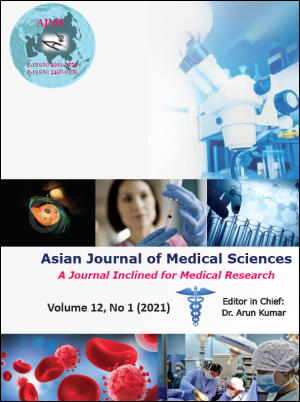Study of patient profile of children with poor/delayed speech in a tertiary care centre in Western Uttar Pradesh, India
Keywords:
Delayed speech, Highrisk infants, Otoacoustic emission, Hearing screening, Congenital sensorineural hearing lossAbstract
Background: Humans convey their emotions and information to one another through language. Delayed or poor speech can have a profound effect on the social and professional life of a person.
Aim and Objectives: A study of children with poor/delayed speech in a tertiary care centre in western U.P. Objectives were as follows • To study the risk factors for congenital hearing loss in children with poor/no speech. • To screen them regarding their hearing status. • To analyze results in detail and compare with available literature.
Materials and Methods: A hospital based prospective observational study was done from Jan - Dec 2019. One-hundred fifteen children were identified. Hearing screening was done in all of them by OAE testing followed by tympanometry and BERA wherever applicable.
Results: Out of 115 children, 9 (7.8%) had normal hearing, 9 (7.8%) had central cause of deafness and 97 (84.4%) had congenital SNHL. 64% of subjects were male (p value- <0.001). 79% of them had an association with some risk factor during birth (p value- <0.001). 40.8% of them were first order in birth with a typical age group presentation of 2-3 yrs. 60.1% of the study population with SNHL had history of normal delivery at home.
Conclusion: Improvement in the quality of antenatal care, obstetric services and postnatal care will reduce the number of cases of congenital sensorineural deafness significantly by reducing the number of high-risk babies. Moreover, the introduction of practice of universal hearing screening of newborns will help in identifying them early for proper rehabilitation.
Downloads
Downloads
Published
How to Cite
Issue
Section
License
Authors who publish with this journal agree to the following terms:
- The journal holds copyright and publishes the work under a Creative Commons CC-BY-NC license that permits use, distribution and reprduction in any medium, provided the original work is properly cited and is not used for commercial purposes. The journal should be recognised as the original publisher of this work.
- Authors are able to enter into separate, additional contractual arrangements for the non-exclusive distribution of the journal's published version of the work (e.g., post it to an institutional repository or publish it in a book), with an acknowledgement of its initial publication in this journal.
- Authors are permitted and encouraged to post their work online (e.g., in institutional repositories or on their website) prior to and during the submission process, as it can lead to productive exchanges, as well as earlier and greater citation of published work (See The Effect of Open Access).




